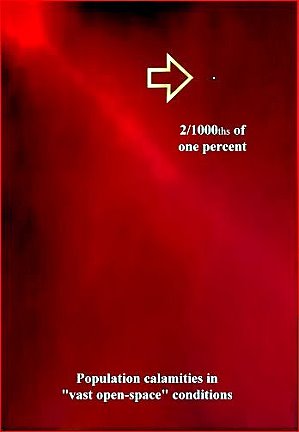|
![]()
| Human population-environment thresholds in earth systems? Klausimas1 #146242 Three classical climb-and-collapse population-environment calamities in "vast open-space conditions" (99.998% "empty" real-world environments) featured mass mortalities and/or 99% die-offs as seen in outbreaks of red-tide, and two reindeer studies on Alaskan islands (Scheffer 1951; Klein 1968). |
BIOSPHERIC ECOSYSTEM LIMITS FOR HUMAN POPULATIONS?
(1) In population dynamics, red-tide dinoflagellates (such as Karenia brevis) constitute quintessential real-world examples of population explosions that produce calamity by their release of wastes into their surroundings. During such red tides, the dinoflagellate cells themselves physically occupy LESS THAN 2/1000ths of one percent of the water volume in which they reside (see the dot in the image). The fact that dinoflagellate populations can induce calamity (by their production of wastes) even when seemingly “vast amounts of open-space” appear to remain theoretically-available would seem to be worth noting since our own species appears to exhibit an extraordinarily similar pattern of behavior.

It is also worth noting that while K. brevis cells release only their biological, cellular, and metabolic wastes into their surroundings, our own species supplements its biological wastes with avalanches of industrial and societal wastes. In addition, it would seem worth noting that our own behavior in this respect is not a localized phenomenon, but that our species-wide supplementary wastes are released, repeatedly and endlessly, into the “onion-skin-thin films” that comprise the atmosphere and waters of the entire earth on a daily, ongoing, planet-wide, and ever-increasing basis.
It should also be disquieting that our species is unique in its tendency to inflict massive, daily, ever-growing, and planetary-scale levels of sheer physical damage to, destruction of, and eradication upon the only planetary life-support machinery so far known to exist anywhere in the universe. And this destruction and eradication is not a minimal or minor footnote to our biology, but instead constitutes one of our most pronounced, distinguishing, and all-encompassing characteristics. No other animals do this, and no other animals in the history of the earth have EVER done this; so that our own species may, perhaps, be on a trajectory that is not only worse than that of an outbreak of red-tide dinoflagellates, but may be multiple orders of magnitude worse at that. No human body, space vehicle, or motor vehicle, for example, could be expected to continue to function if 60-70-80 or 90% of its operating systems are damaged, eradicated, and/or destroyed. Why then, should we suppose that earth's biospheric life-support machinery is invulnerable?
(2) Two other classical examples of population catastrophes (with 99% die-offs) in environments that visually appeared to remain almost entirely empty (again, with thresholds of roughly 2/1000ths of 1% occupied) are seen in two separate and independent studies of mammals (reindeer) on two Alaskan islands (V.B. Scheffer, 1951 and D.R. Klein, 1968), so that in this single post we cite three separate, classical, independent, and quintessential documentations of massive population calamities in “vast open-space” conditions and environmental surroundings that appear to remain almost entirely empty.
Note that the tiny white dot in the above image denotes conditions that are ALREADY “TOO LATE”
(3) We need to consider a third critical aspect of the image that we address in this topic: The tiny 2/1000ths of 1% conditions denoted by the tiny white dot in the image (which roughly summarizes all three classical population-environment calamities that we cite) actually reflect conditions that have ALREADY begun to unfold and a disaster that is BEGINNING or is ALREADY well-underway in all three cases. In other words, for the real-world populations involved, whose combined bodies (or cells) physically-occupy only the tiny fraction of their environment as represented by the tiny white dot, the image denotes conditions that are already TOO LATE, in which the critical population-environment threshold has ALREADY BEEN BREACHED. In other words, for all three examples, the real-world organisms involved have already WAITED TOO LONG, so that, in order to avoid the calamitous outcomes that the image denotes, precautionary measures would have been required MUCH sooner.
(4) Assume, then, for the sake of argument, that all three population-environment crises denoted by the image involved sentient and intelligent organisms. If their societies, leaders, and citizens WAIT until the depicted conditions develop, they will have already waited too long, so that if they are to avoid calamity, preventive and precautionary measures will be required well before the depicted conditions emerge. How much sooner? To avoid calamity, each of the three populations would have to stabilize AT LEAST one or two, or for true safety, three “doubling-times” sooner).If that is the case, the organisms, their societies, and their leaders would have to both recognize and act upon their trajectories, implications, and outcomes at a time when the “combined occupancy dot” that they occupy is just one-half or one-quarter (or one-eighth) the size of the dot depicted in the conditions above.
Supporting mathematics and discussion of the three cited examples are accessible at the following links: PDF - Three calamitous population thresholds in "vast open-space" conditions at
http://www.scribd.com/fullscreen/81278312?access_key=key-r945rtq3hxbe7lnfn68 and similar discussion and mathematics is presented in PowerPoint format at http://www.scribd.com/fullscreen/29284061?access_key=key-1d5uc7f665roaubtur7w
|
|
|